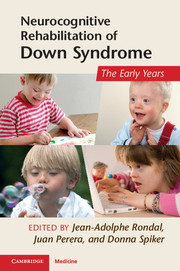Book contents
- Frontmatter
- Contents
- List of contributors
- Preface
- Acknowledgments
- Section 1 Definition, history, methodology, and assessment
- Section 2 Genetics, brain, and animal models
- 4 New perspectives on molecular and genic therapies in Down syndrome
- 5 Brain plasticity and environmental enrichment in Ts65Dn mice, an animal model for Down syndrome
- 6 Development of the brain and metabolism
- Section 3 Pharmacological and medical management and treatment
- Section 4 Early development and intervention
- Section 5 Therapeutic perspectives
- Conclusions
- Index
- References
6 - Development of the brain and metabolism
Published online by Cambridge University Press: 05 July 2011
- Frontmatter
- Contents
- List of contributors
- Preface
- Acknowledgments
- Section 1 Definition, history, methodology, and assessment
- Section 2 Genetics, brain, and animal models
- 4 New perspectives on molecular and genic therapies in Down syndrome
- 5 Brain plasticity and environmental enrichment in Ts65Dn mice, an animal model for Down syndrome
- 6 Development of the brain and metabolism
- Section 3 Pharmacological and medical management and treatment
- Section 4 Early development and intervention
- Section 5 Therapeutic perspectives
- Conclusions
- Index
- References
Summary
Introduction
Down syndrome (DS) is the most common genetic cause of significant intellectual disability, affecting roughly 1 in 733 live births in the United States (Centers for Disease Control and Prevention, 2006). It is caused by trisomy of human chromosome 21 (HSA21) and was the first autosomal trisomy identified, a seminal contribution to human genetics (Lejeune et al., 1959). Over 220,000 babies will be born with DS this year worldwide. The features of DS have been described in detail in the past (Roizen & Patterson, 2003; other chapters in this book). Here we focus on the effects of metabolism on brain development. As discussed in the following sections, the effects of nutritional status and levels of particular nutrients that alter metabolism early in development can have profound effects on brain function later in life, at least in animals like the mouse and rat. This topic is of great importance in the context of DS as many attempts to ameliorate the intellectual and other disabilities confronted by individuals with DS have been tried over the years. To date, none of these proposed interventions has been based on validated scientific evidence. Some have been based, at least in part, on limited data regarding biochemical differences observed between people with and without DS, and some have been based on hypotheses derived from the gene content of HSA21 (Salman, 2002; Roizen, 2005).
- Type
- Chapter
- Information
- Neurocognitive Rehabilitation of Down SyndromeEarly Years, pp. 85 - 95Publisher: Cambridge University PressPrint publication year: 2011
References
- 1
- Cited by



